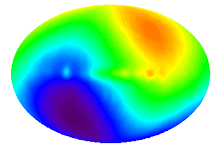A Common Mechanism of
Cellular Death Induced by Bactericidal Antibiotics
Antibiotic
mode-of-action classification is based upon drug-target interaction and whether
the resultant inhibition of cellular function is lethal to bacteria. Here we
show that the three major classes of bactericidal antibiotics, regardless of
drug-target interaction, stimulate the production of highly deleterious
hydroxyl radicals in Gram-negative and Gram-positive bacteria, which ultimately
contribute to cell death. We also show, in contrast, that bacteriostatic drugs
do not produce hydroxyl radicals. We demonstrate that the mechanism of hydroxyl
radical formation induced by bactericidal antibiotics is the end product of an
oxidative damage cellular death pathway involving the tricarboxylic acid cycle,
a transient depletion of NADH, destabilization of iron-sulfur clusters, and
stimulation of the Fenton reaction. Our results suggest that all three
major classes of bactericidal drugs can be potentiated by targeting bacterial
systems that remediate hydroxyl radical damage, including proteins involved in
triggering the DNA damage response.
Current antimicrobial
therapies, which cover a wide array of targets , fall into two general
categories: bactericidal drugs, which kill bacteria with an efficiency of
>99.9%, and bacteriostatic drugs, which merely inhibit growth.
Antibacterial
drug-target interactions are well studied and predominantly fall into three
classes: inhibition of DNA replication and repair, inhibition of protein
synthesis, and inhibition of cell-wall turnover.
Bacteriostatic drugs
predominantly inhibit ribosome function, targeting both the 30S (tetracycline
family and aminocyclitol family) and 50S (macrolide family and chloramphenicol)
ribosome subunits.
With regard to other
classes of bactericidal antibiotics, quinolones target DNA replication and
repair by binding DNA gyrase complexed with DNA, which drives double-strand DNA
break formation and cell death.
Cell-wall synthesis
inhibitors (such as β-lactams), which interact with penicillin-binding proteins.
and glycopeptides that
interact with peptidoglycan building blocks, interfere with normal cell-wall
synthesis and induce lysis and cell death.
We have recently shown
that bacterial gyrase inhibitors, including synthetic quinolone antibiotics and
the native proteic toxin CcdB, induce a breakdown in iron regulatory dynamics,
which promotes formation of reactive oxygen species that contribute to cell
death.
Hydroxyl radical
formation utilizing internal iron and the Fenton reaction appears to be the
most significant contributor to cell death among the reactive oxygen species
formed. The Fenton reaction leads to the formation of hydroxyl radicals through
the reduction of hydrogen peroxide by ferrous iron. We chose to investigate
whether hydroxyl radical formation also contributes to antibiotic-induced cell
death in bacteria among the other classes of antibiotics. Here we report that
the three major classes of bactericidal antibiotics, regardless of drug-target
interaction, stimulate hydroxyl radical formation in bacteria. Furthermore, we
demonstrate that hydroxyl radical generation contributes to the killing
efficiency of these lethal drugs. We also show, in contrast, that
bacteriostatic drugs do not produce hydroxyl radicals. We demonstrate that all
bactericidal drug classes utilize internal iron from iron-sulfur clusters to
promote Fenton-mediated hydroxyl radical formation and show that these events
appear to be mediated by the tricarboxylic acid (TCA) cycle and a transient
depletion of NADH. We propose that there is a common mechanism of cellular
death underlying all classes of bactericidal antibiotics whereby harmful
hydroxyl radicals are formed as a function of metabolism-related NADH
depletion, leaching of iron from iron-sulfur clusters, and stimulation of the
Fenton reaction.

沒有留言:
張貼留言